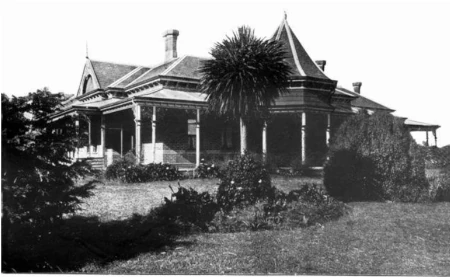![]()
Reprinted from the Beaconsfield Banner, Spring 2017
Charles James George Nott was born on 16 March 1844 in Marylebone, Middlesex, England. His parents, Robert and Martha Nott, decided to seek their fortune in Australia as some extended family had already immigrated.
On 25 August 1852 aboard the ship ‘Priam’ Robert, Martha and their four children arrived in Melbourne, Australia. Shortly after in 1853 eldest daughter Martha married Charles Hayes in Melbourne. After the marriage Robert Nott and his son-in-law Charles moved north and operated a carrier business in the Beechworth area. By 1859 they had moved to Chinaman’s Flat near Maryborough, a gold mine district. It is recorded that Charles’ interest was in carpentry rather than mining. He built his parents a house and another house for himself to live in with his bride, cousin Matilda Catherine Nott, whom he married at St James Church, Melbourne on 14 March 1872. The following year they began their family with the birth of a daughter, Malvina Matilda.
By 1874 Charles had filed at the local court of insolvency. Charles and Matilda left Chinaman’s Flat for the Melbourne suburb Prahran. Charles established himself in the building business as a contractor, employing architects and skilled tradesman to build palatial homes. While the business continued and their family grew they lived in homes owned by their extended family until the Discharge of Insolvency was completed on 17 July 1883. Charles built his new mansion ‘St. Cloud’ in Grandview Grove, Prahran. As the 1880’s continued so did the portfolio of properties Charles purchased and developed. This would extend to the purchase of land in Beaconsfield to build his family a country residence. He had plans not only to build his own mansion but to subdivide the acreage purchased near the railway station and along the Gippsland Road (Princes Highway) for building purposes.
Charles built the magnificent mansion, ’Kenilworth Villa’, at Beaconsfield. The reason for the name ‘Kenilworth’ is unknown. Kenilworth in Warwickshire, England is some distance from Marylebone where Charles was born and lived so this reason seems unlikely. Perhaps Matilda and their daughters named the villa after the novel ‘Kenilworth A Romance’ written Sir Walter Scott.

Unfortunately speculation and building was about to end most abruptly best described as follows in April 1892.
Victorian Property Collapse a ‘disaster’.
A leading London finance journal yesterday published a report which branded Melbourne’s property collapse as a ‘chain of disasters’. The Economist said the scale of the collapse in Melbourne was the worst in the history of the colonies. The litany of financial failures, it said, had highlighted the need for colonial governments to curtail their loan expenditure. Over 50 large and small banks, building societies and property companies in NSW, Victoria and Queensland have been forced to suspend payment over the past 6 months. British investors as well as individual Australian depositors, had lost millions thanks to the collapse of the property market. It was felt that the promotion of the land boom had over rated the value. An enormous amount of money, in the shape of capital and deposits, is locked up, and the income accruing from it ceased, partly because paralysis inevitably fell upon the market in real estate, and partly because colonial depositors taking alarm have for some time past been drawing out faster than the British depositors paid in. Among the Melbourne companies that sunk in early 1892 are the freehold Investment and Banking Co, the Victorian Mortgage and Deposit Bank and the English and Australian Mortgage Bank. The collapse was a ‘domino effect’ bringing an end to the boom of the 1880’s.
On 21 April 1892 Charles Nott instructed the public auction of his properties which included ‘Kenilworth’ and described as follows;
Lot 1; Beaconsfield Almost adjoining the Railway station- Commodious family residence well and substantially built on stone foundations, containing grand entrance hall,10ft and 8ft wide, 12 rooms (32 x 21,22 x 16, 20 x 16, 18 x 16) principal ones all handsomely decorated. French polished dados, wardrobes, mantles and over mantles, bathroom (hot and cold water), storeroom, laundry, servants room, 300ft of broad veranda all round, six tanks, brick stables (Four stalls), double coach house, man’s and harness room, hay loft other tanks etc. the land comprising 38 acres laid out in orchard and flower garden, ornamental lakes, etc.
Lot 2 Close to the above, Weatherboard Villa containing seven rooms light & power and decorated, bathroom, pantry, laundry, two small stable coach house, man’s room, two tanks. Land about 3 ½ acres fruit and flower garden.
After the sale of ‘Kenilworth’ to Montague Cohen, Charles and Matilda selected land at Budgeree near Mirboo North which the government had opened up for settlement. They named their new property ‘Kenilworth Park’ where Charles’ occupation was recorded as grazier until he died in 1907.
![]()
‘Kenilworth Villa’ became a Foundling home in 1913. After the Foundling home was closed in 1940, it was rented to many people and fell into disrepair. Kenneth and Hilda Tozer purchased the villa in 1963 with plans to renovate but decided to demolish and build a new home which incorporated some of the materials from the villa.
Today Charles Nott’s villa is a distant past, all that remains are the stables which have been converted into a home and the weatherboard house, known as the Railway House.
![]()
![]()